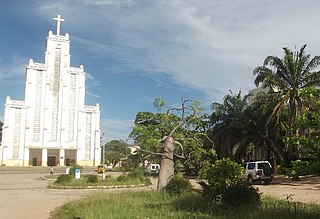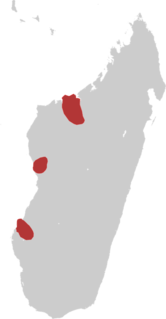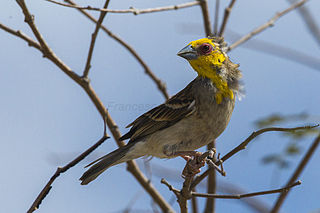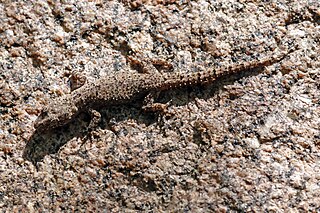
Ploceidae is a family of small passerine birds, many of which are called weavers, weaverbirds, weaver finches and bishops. These names come from the nests of intricately woven vegetation created by birds in this family. In most recent classifications, Ploceidae is a clade, which excludes some birds that have historically been placed in the family, such as some of the sparrows, but which includes the monotypic subfamily Amblyospizinae. The family is believed to have originated in the mid-Miocene. All birds of the Ploceidae are native to the Old World, most in Africa south of the Sahara, though a few live in tropical areas of Asia. A few species have been introduced outside their native range.

Mahajanga[maːˈdzaŋɡə̥] is a city and an administrative district on the northwest coast of Madagascar.

The Sakalava are an ethnic group of Madagascar. They are found on the western and northwest region of the island, in a band along the coast. The Sakalava are one of the smaller ethnic groups, constituting about 6.2 percent of the total population, that is over 1,210,000 in 2014. Their name means "people of the long valleys." They occupy the western edge of the island from Toliara in the south to Sambirano in the north.

Ankarafantsika National Park is a national park in the Boeny Region of Madagascar. The closest city is Majunga 115 kilometres (71 mi) north of the park. Ankarafantsika is mostly tropical in climate type. The Sakalava people are the predominant ethnic group living and farming here. The greater big-footed mouse lives in the park and is not known anywhere else.

Menabe is a region in western Madagascar, with its capital at Morondava. It covers an area of 46,121 square kilometres, and its population was 700,577 in 2018. The population mostly belongs to the Sakalava ethnic group. The region is named after the 18th-century Sakalava Kingdom of Menabe. The name "Menabe", in turn, means "big red", after the color of laterite rock that dominates the landscape.

The Sakalava rail is a species of bird in the family Rallidae. It is endemic to Madagascar. Its natural habitats are rivers, swamps, freshwater lakes, and freshwater marshes. It is threatened by habitat loss.

The Sakalava weaver sometimes known as the Sakalava fody is a species of bird in the family Ploceidae. It is endemic to Madagascar. The bird is 15 cm (5.9 in) long and weighs 20–28 g (0.71–0.99 oz).

Ambohijanahary Special Reserve is a wildlife reserve in the regions of Menabe and Melaky in Madagascar. The reserve was created in 1958 to protect the sclerophyllous forest between Tsiroanomandidy and Maintirano, as well as protecting the many endemic species of plants and animals.

Bemarivo Reserve is a wildlife reserve in the north-west of Madagascar. It was created in 1956 and covers an area of 12,080 hectares. The reserve is known for its fauna especially endemic birds.

Kasijy Special Reserve is a 19,800 hectares wildlife reserve in the Betsiboka region of Madagascar. Nearly half of the species of plants and animals recorded within the reserve are endemic to Madagascar and BirdLife International have listed the reserve as an Important Bird Area.
Maningoza Special Reserve is a 9,826 hectares wildlife reserve in Madagascar. It was created in 1956 to protect the many endemic plants and animals, and it also contains some of the last remaining areas of dry deciduous forest on the island.
Manongarivo Reserve is a wildlife reserve in the North-West of Madagascar in the region of Diana.

Senegalia is a genus of flowering plants in the family Fabaceae. It belongs to the Mimosoid clade. Until 2005, its species were considered members of Acacia. The genus is still considered polyphyletic and will require further division. Senegalia can be distinguished from other acacias by its spicate inflorescences and non-spinescent stipules.

Vachellia is a genus of flowering plants in the legume family, Fabaceae, commonly known as thorn trees or acacias. It belongs to the subfamily Mimosoideae. Its species were considered members of genus Acacia until 2009. Vachellia can be distinguished from other acacias by its capitate inflorescences and spinescent stipules. Before discovery of the New World, Europeans in the Mediterranean region were familiar with several species of Vachellia, which they knew as sources of medicine, and had names for them that they inherited from the Greeks and Romans.
Senegalia pervillei is a species of Senegalia that is endemic to Madagascar. The species was first formally described by English botanist George Bentham in 1875 in Transactions of the Linnean Society of London. Two varieties are recognised:

The Antankarana are an ethnic group of Madagascar inhabiting the northern tip of Madagascar, around Antsiranana. Their name means "the people of the tsingy," the limestone rock formations that distinguish their traditional territory. The tsingy of the Antankarana may be visited at the Ankarana Reserve. There are over 50,000 Antakarana in Madagascar as of 2013.
The Masikoro are a group of farmers and herders who inhabit areas surrounding the Mikea Forest, a patch of mixed spiny forest and dry deciduous forest along the coast of southwestern Madagascar in Toliara Province. Along with Vezo and Mikea, the Masikoro are Sakalava people, the difference being that Masikoro are of the land, Vezo are of the sea, and Mikea are of the forest.

Blaesodactylus sakalava, the Sakalava velvet gecko is a species of gecko endemic to Madagascar.

Conus sakalava is a species of sea snail, a marine gastropod mollusk in the family Conidae, the cone snails, cone shells or cones.













